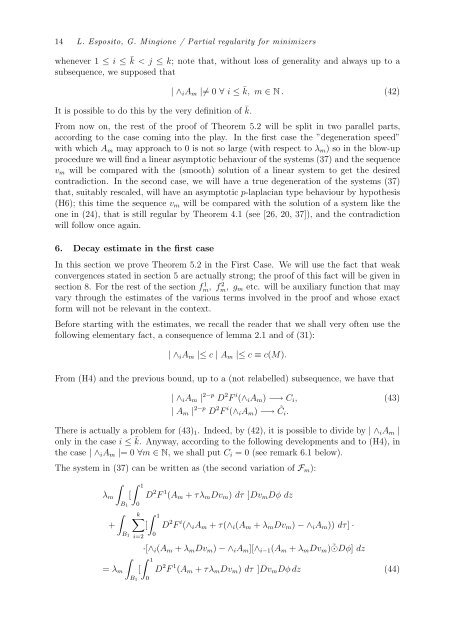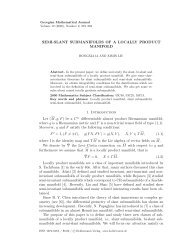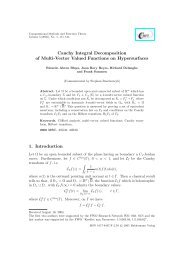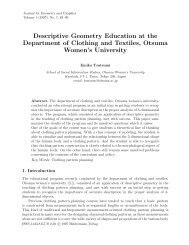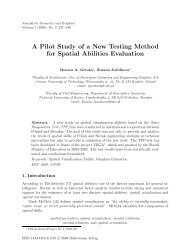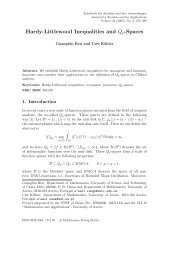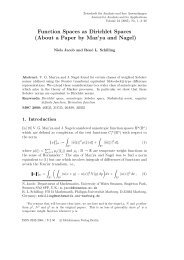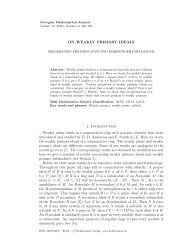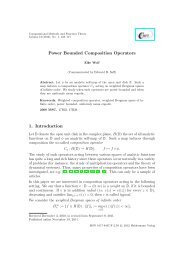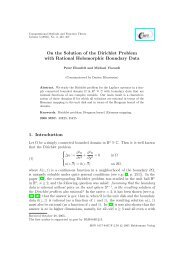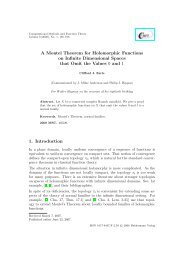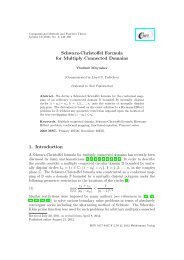Partial Regularity for Minimizers of Degenerate Polyconvex Energies
Partial Regularity for Minimizers of Degenerate Polyconvex Energies
Partial Regularity for Minimizers of Degenerate Polyconvex Energies
You also want an ePaper? Increase the reach of your titles
YUMPU automatically turns print PDFs into web optimized ePapers that Google loves.
14 L. Esposito, G. Mingione / <strong>Partial</strong> regularity <strong>for</strong> minimizers<br />
whenever 1 ≤ i ≤ ¯k < j ≤ k; note that, without loss <strong>of</strong> generality and always up to a<br />
subsequence, we supposed that<br />
It is possible to do this by the very definition <strong>of</strong> ¯k.<br />
| ∧ i A m |≠ 0 ∀ i ≤ ¯k, m ∈ N . (42)<br />
From now on, the rest <strong>of</strong> the pro<strong>of</strong> <strong>of</strong> Theorem 5.2 will be split in two parallel parts,<br />
according to the case coming into the play. In the first case the degeneration speed<br />
with which A m may approach to 0 is not so large (with respect to λ m ) so in the blow-up<br />
procedure we will find a linear asymptotic behaviour <strong>of</strong> the systems (37) and the sequence<br />
v m will be compared with the (smooth) solution <strong>of</strong> a linear system to get the desired<br />
contradiction. In the second case, we will have a true degeneration <strong>of</strong> the systems (37)<br />
that, suitably rescaled, will have an asymptotic p-laplacian type behaviour by hypothesis<br />
(H6); this time the sequence v m will be compared with the solution <strong>of</strong> a system like the<br />
one in (24), that is still regular by Theorem 4.1 (see [26, 20, 37]), and the contradiction<br />
will follow once again.<br />
6. Decay estimate in the first case<br />
In this section we prove Theorem 5.2 in the First Case. We will use the fact that weak<br />
convergences stated in section 5 are actually strong; the pro<strong>of</strong> <strong>of</strong> this fact will be given in<br />
section 8. For the rest <strong>of</strong> the section f 1 m, f 2 m, g m etc. will be auxiliary function that may<br />
vary through the estimates <strong>of</strong> the various terms involved in the pro<strong>of</strong> and whose exact<br />
<strong>for</strong>m will not be relevant in the context.<br />
Be<strong>for</strong>e starting with the estimates, we recall the reader that we shall very <strong>of</strong>ten use the<br />
following elementary fact, a consequence <strong>of</strong> lemma 2.1 and <strong>of</strong> (31):<br />
| ∧ i A m |≤ c | A m |≤ c ≡ c(M).<br />
From (H4) and the previous bound, up to a (not relabelled) subsequence, we have that<br />
| ∧ i A m | 2−p D 2 F i (∧ i A m ) −→ C i , (43)<br />
| A m | 2−p D 2 F i (∧ i A m ) −→ ˜C i .<br />
There is actually a problem <strong>for</strong> (43) 1 . Indeed, by (42), it is possible to divide by | ∧ i A m |<br />
only in the case i ≤ ¯k. Anyway, according to the following developments and to (H4), in<br />
the case | ∧ i A m |= 0 ∀m ∈ N, we shall put C i = 0 (see remark 6.1 below).<br />
The system in (37) can be written as (the second variation <strong>of</strong> F m ):<br />
λ m<br />
∫B 1<br />
[<br />
∫<br />
+<br />
B 1<br />
∫ 1<br />
0<br />
k∑<br />
[<br />
i=2<br />
= λ m<br />
∫B 1<br />
[<br />
D 2 F 1 (A m + τλ m Dv m ) dτ ]Dv m Dφ dz<br />
∫ 1<br />
0<br />
D 2 F i (∧ i A m + τ(∧ i (A m + λ m Dv m ) − ∧ i A m )) dτ] ·<br />
·[∧ i (A m + λ m Dv m ) − ∧ i A m ][∧ i−1 (A m + λ m Dv m ) ˜⊙Dφ] dz<br />
∫ 1<br />
0<br />
D 2 F 1 (A m + τλ m Dv m ) dτ ]Dv m Dφ dz (44)


